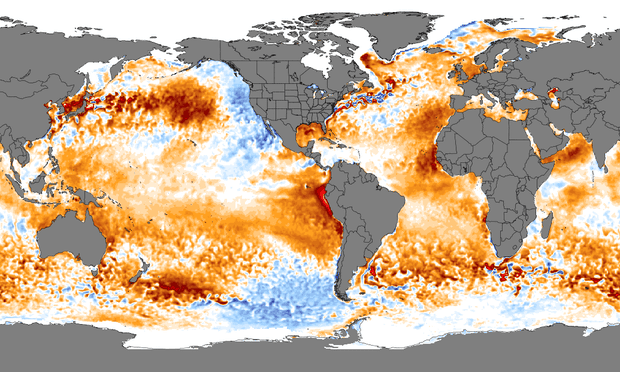Scientists warn of more marine heatwaves, leading to increased risk of extreme weather
The temperature of the world’s ocean surface has hit an all-time high since satellite records began, leading to marine heatwaves around the globe, according to US government data.
Climate scientists said preliminary data from the National Oceanic and Atmospheric Administration (Noaa) showed the average temperature at the ocean’s surface has been at 21.1C since the start of April – beating the previous high of 21C set in 2016.
“The current trajectory looks like it’s headed off the charts, smashing previous records,” said Prof Matthew England, a climate scientist at the University of New South Wales.
Three years of La Niña conditions across the vast tropical Pacific have helped suppress temperatures and dampened the effect of rising greenhouse gas emissions.
But scientists said heat was now rising to the ocean surface, pointing to a potential El Niño pattern in the tropical Pacific later this year that can increase the risk of extreme weather conditions and further challenge global heat records.
Dr Mike McPhaden, a senior research scientist at Noaa, said: “The recent ‘triple dip’ La Niña has come to an end. This prolonged period of cold was tamping down global mean surface temperatures despite the rise of greenhouse gases in the atmosphere.
“Now that it’s over, we are likely seeing the climate change signal coming through loud and clear.”
La Niña periods – characterised by cooling in the central and eastern tropical Pacific and stronger trade winds – have a cooling influence on global temperatures. During El Niño periods, the ocean temperatures in those regions are warmer than usual and global temperatures are pushed up.
According to the Noaa data, the second-hottest globally averaged ocean temperatures coincided with El Niño that ran from 2014 to 2016.
Ocean surface temperatures are at a record high
Average daily sea surface temperature, 60S to 60N
< View the graphics at the source page. >
The data is driven mostly by satellite observations but also verified with measurements from ships and buoys. The data does not include the polar regions.
More than 90% of the extra heat caused by adding greenhouse gases to the atmosphere from burning fossil fuels and deforestation has been taken up by the ocean.
A study last year said the amount of heat accumulating in the ocean was accelerating and penetrating deeper, providing fuel for extreme weather.
England, a co-author of that study, said: “What we are seeing now [with the record sea surface temperatures] is the emergence of a warming signal that more clearly reveals the footprint of our increased interference with the climate system.”
Measurements from the top 2km of the ocean show the rapid accumulation of heat in the upper parts of the ocean, particularly since the 1980s.
Dr Kevin Trenberth, a climate scientist and distinguished scholar at the US National Center for Atmospheric Research, said observations showed the heat in the tropical Pacific was extending down to more than 100 metres.
He said that heat would have knock-on effects for the atmosphere above, creating more heat, adding energy to weather systems and causing marine heatwaves.
Dr Alex Sen Gupta, an associate professor at the UNSW Climate Change Research Centre, said satellites showed that on the ocean surface, temperature rises had been “almost linear” since the 1980s.
“What’s been surprising is that the last three years have also been really warm, despite the fact that we’ve had La Niña conditions,” he said. “But it is now warmer still and we are getting what looks like record temperatures.”
Sen Gupta is part of an international team of scientists studying marine heatwaves – which are classified by his group as an area of the ocean where temperatures are in the top 10% ever recorded for that time of year for at least five straight days.
Current observations show moderate to strong marine heatwaves in several regions, including the southern Indian Ocean, the south Atlantic, off north-west Africa, around New Zealand, off the north-east of Australia and the west of Central America.
< View the graphics at the source page. >
“It’s unusual to see so many quite extreme marine heatwaves all at the same time,” said Sen Gupta.
While marine heatwaves can be driven by local weather conditions, studies have shown they have increased in frequency and intensity as the oceans have warmed – a trend forecast to worsen with human-caused global heating.
Hotter oceans provide more energy for storms, as well as putting ice sheets at risk and pushing up global sea levels, caused by salt water expanding as it warms.
Marine heatwaves can also have devastating effects on marine wildlife and cause coral bleaching on tropical reefs. Experiments have also suggested that warming oceans could radically alter the food web, promoting the growth of algae while lowering the types of species that humans eat.
Prof Dietmar Dommenget, a climate scientist and modeller at Monash University, said the signal of human-caused global heating was much clearer in the oceans.
“Obviously we’re in a fast-warming climate and we’re going to see new records all the time. A lot of our forecasts are predicting an El Niño.
“If this happens, we’ll see new records not just in the ocean but on land. This data is already suggesting we’re seeing a record and there could be more coming later this year.”
- alf9872000
-

 1
1



Recommended Comments
There are no comments to display.
Join the conversation
You can post now and register later. If you have an account, sign in now to post with your account.
Note: Your post will require moderator approval before it will be visible.